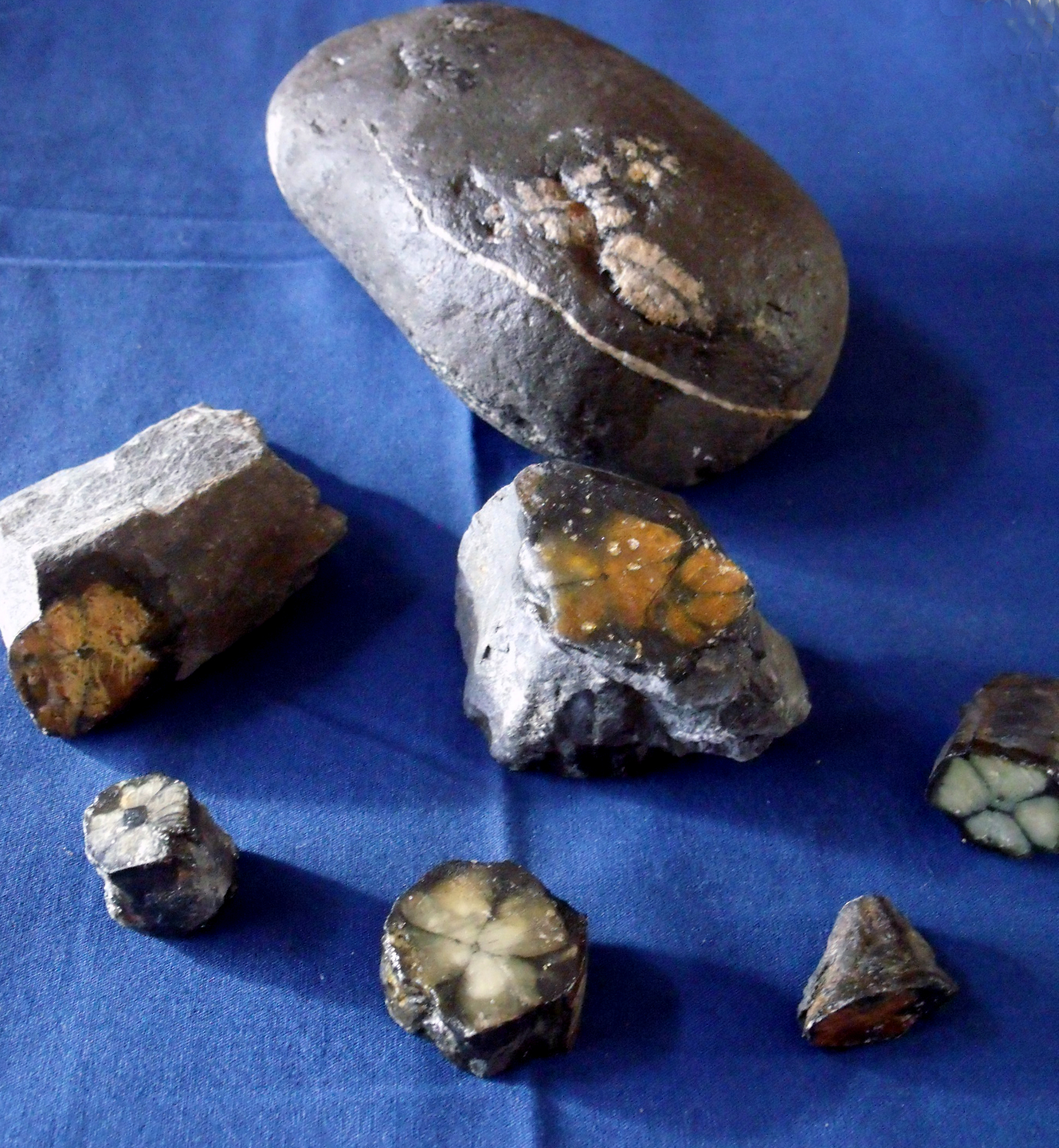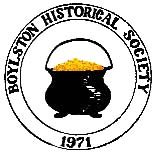Chiastollites
Chiastolites
By Judy Haynes
The beautiful stones in our Boylston Historical Society 
It is noted that there are only three active localities in the world with Lancaster and Sterling in Central Massachusetts as one of those three active sites, so we have a rare find. Asturias, Spain and the Bimbowrie Conservation Park in Olary Province, South Australia, are the other active locales. Chiastolites may be found in other places, but are not actively mined
In the earliest colonial days Boylston, Massachusetts was part of the Lancaster Land Grant. This geographical area is on the Clinton-Newbury fault line, and is the kind of landscape where chiastolites are found as the metamorphism of shale occurs in a vicinity where tectonic plates come together. When those early settlers near today’s Lancaster were looking for iron ore, silver, and gold, they were fascinated by a stone that when split open displayed a cross; thus, they assumed it might hold special qualities. Samples were shipped to England for the Royals to see, and they supposedly were captivated by them. Mines were opened in Lancaster and neighboring Sterling so they might be extracted and sent to England and to Europe where many are still displayed in museums.
Though attractive to look at, they were dull, earthy crystals and not hard enough to be suitable as a true gem. It was the pattern, primarily, that leant its value and symbolism; thus, it was favored as an amulet, charm, and talisman. Many were found by archaeologists when digging in Native American (Nashaway) sites of this area. Those excavated stones were found to have been polished, leading one to believe they held special meaning to the Nashaway people. One historian wrote that Native Americans believed heavily in the protective aspects this mineral provided and would have this stone talisman with them to ward off negative vibrations during rituals and ceremonies, but none of this has been verified by anthropologists studying the Nashaway. However, they were considered valuable and important enough to be traded with other tribes. Believers in crystals feel a chiastolite provides positive energy, mental clarity, inner peace, and connects their energies to that of Mother Earth. Some believed the stone bestowed strength, power, perseverance, and was extremely calming when held in one’s hands.
Even into the 1980s there were people in the Lancaster, Massachusetts area looking for ‘cross stones.’ One person related that her mother found two in a stone wall near Blood Forest, Lancaster. She found round lumps in the rock and used a rock chisel to open and to expose the special symbol. The daughter noted “Sometimes beautiful things can be hiding in plain sight.” She no longer has the stones, but wishes she had this special memory of her mother’s and their forays to look for chiastolite stones.
When COVID-19 is history and we are once again open, come to the Boylston Historical Society and Museum and witness these rare stones first hand.
________________
Acknowledgements:Arem, Joel, Color Encyclopedia of Gemstones, 1987, as noted in Hoffman, MacLeod and Smith; Geoscience News and Information, https://geology.com Lancaster Historical Society; Hoffman, MacLeod, and Smith, Symbols in Stone: Chiastolites in New England Archaeology, Bulletin of the Massachusetts Archaeological Society, Vol 60(1), 1999; Kunz, George F., The Curious Lore of Precious Stones: being a description of their sentiments and folk lore, superstitions, symbolism, mysticism, use in medicine, protection, prevention, religion, and divination, crystal gazing, birthstones, lucky stones and talismans, astral, zodiacal and planetary, 1913, https://catalog.hathitrust.org/Record/001277254; Museum of Applied Arts & Sciences, https://collection.maas.museum/object/3215 Photography by Nancy Filgate, Boylston HIstorical Society & Museum, curator & director Torrubia, Jose, Aparato para la historia Natural de la Nueva Espana, 1754; The Crystal Council.com; Wikipedia: chiastolites; https://en.wikipedia.org/wiki/Chiastolite
